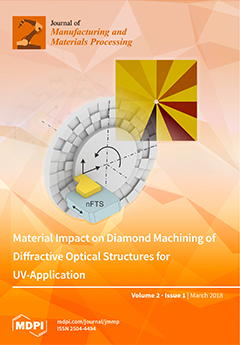Due to their high ductility, high durability, and excellent corrosion resistance, stainless steels are attractive materials for a variety of applications. However, high work hardening, low thermal conductivity, and high built-up edge (BUE) formation make these materials difficult to machine. Rapid tool wear
[...] Read more.
Due to their high ductility, high durability, and excellent corrosion resistance, stainless steels are attractive materials for a variety of applications. However, high work hardening, low thermal conductivity, and high built-up edge (BUE) formation make these materials difficult to machine. Rapid tool wear and high cutting forces are the common problems encountered while machining these materials. In the present work, the application of Taguchi optimization methodology has been used to optimize the cutting parameters of the drilling process for machining two stainless steels: austenitic AISI 304 and duplex AISI 2205 under dry conditions. The machining parameters which were chosen to be evaluated in this study are the tool material, cutting speed, and feed rate, while, the response factors to be measured are the tool life (
T), cutting force (
Fc), and specific cutting energy (
ks). Additionally, empirical models were created for predicting the
T,
Fc and
ks using linear regression analysis. The results of this study show that AISI 2205 stainless steel has a shorter tool life, a higher cutting force, and a higher specific cutting energy than AISI 304 stainless steel. In addition, the Taguchi method determined that A
3B
1C
1 and A
3B
3C
1 (A
3 = TiN-coated twist drill, B
1 = 13 m/min, B
3 = 34 m/min, C
1 = 0.12 mm/rev) are the optimized combination of levels for the best tool life and the lowest cutting force, respectively. Meanwhile, the optimized combination of levels for all three control factors from the analysis, which provides the lowest specific cutting energy, was found to be A
3B
1C
3 (A
3 = TiN-coated twist drill, B
1 = 13 m/min, C
3 = 0.32 mm/rev) for both stainless steels.
Full article





